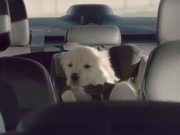Baby Husky Howls
Cute Husky puppy howling for the first time.
Siberian Huskies are strong, compact, working sled dogs. The medium-sized head is in proportion to the body, with a muzzle that is equal in length to the skull, with a well-defined stop. The color of the nose depends upon the color of the dog's coat. It is black in gray, tan or black dogs, liver in copper dogs and flesh-colored in pure white dogs. The medium-sized, oval-shaped eyes are moderately spaced and come in blue, brown, amber or any combination thereof. Eyes can be half blue and half brown (parti-eyed), or dogs can have one blue eye and one brown eye (bi-eyed). The erect ears are triangular in shape, and set high up on the head. The teeth meet in a scissors bite. The tail is carried over the back in a sickle curve, not curved to either side when the dog is excited. The large "snow shoe" feet have hair between the toes to help keep them warm and for gripping on ice. Dewclaws are sometimes removed. The medium-length, double coat is thick and can withstand temperatures as low as -58° to -76° F (-50° to -60° C). The coat also comes in a longhaired variety called a wooly coat. The wooly (sometimes spelled woolly or wooley) coat length comes from a resessive gene and is not in most of the kennel club's written standard. Coat colors include all, from black to pure white, with or without markings on the head. The face mask and underbody are usually white, and the remaining coat any color. Examples of common colors are black and white, red and white, brown, gray and white, silver, wolf-gray, sable and white, red-orange with black tips, dark gray and white. Piebald is a very common coat pattern.



















